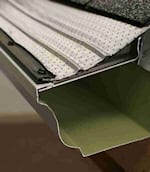Gutter Guard / Leaf Guard: To Use or Not To Use?
 A customer recently asked my opinion about gutter guard (also known as leaf guard). I was happy to provide it, and I think that having previously worked for a company that used to install it, and having cleaned gutters around the GVRD that both have it and don’t, I think I have an informed opinion.
A customer recently asked my opinion about gutter guard (also known as leaf guard). I was happy to provide it, and I think that having previously worked for a company that used to install it, and having cleaned gutters around the GVRD that both have it and don’t, I think I have an informed opinion.
Gutter guard is a big investment for a strata, and the idea is that is should save them on maintenance and save them money long term. Is that actually the case?
Answer: it might cost MORE in maintenance, depending upon the type of leaf guard installed. Or, it may save a bit of money, but in almost all case it does not work as expected.
Gutter guard is supposed to prevent leaves from sitting in your gutter while allowing the water pass through perforations, into the trough, and then be carried away as desired. This is great in theory, the problem is that it ALMOST NEVER works that way!
The worst kind of gutter guard I’ve seen yet was a plastic lattice work or netting that was supposed to sit over the top of the gutter. However, this net sank into the gutter under the weight of the leaves, and the perforations were so large, that it trapped the leaves in them. The result: leaves that couldn’t be cleaned out of the gutter! This was a disastrous, worst case scenario, and certainly cost more than a regualr gutter cleaning. The leaves were held tight like fish in a net, unable to be removed, choking up the gutter system. The only way to get rid of the junk was to remove the netting, which should have been disposed of along with the leaves. I don’t remember what actually ended up happening in that case.
The best designed product is one that I used to install. It is a flat, perforated aluminum that clips onto one side of the gutter, and is fastened down to the other side with screws. Durable, solid, with holes not too large, this looks like the perfect solution. Leaves can’t fit in the holes, water can seep in, it should work perfectly, right?
Wrong.
I’m glad I don’t install this product any more, now that I work with ServiceMaster.
This is Vancouver. We get a lot of leaves falling, and a lot of rain. What happens ot those dead leaves when they’ve been soaked by a day of heavy rainfall? They start to decompose, they compress under their own weight, and become a sticky, thick pasty mess kind of like paper mache. Paper mache, as we all know, sticks to things. What do leaves do that are thick and pasty? They stick to the roof. They stick to the top of the gutter guard.
That is the flaw in the whole scheme. The dead leaves sit on top of the gutter guard, plug up the holes, and the water now runs off the roof, over the leaves, and falls over the edge of the gutter to the ground. That is the scenario gutters are installed to avoid in the first place.
What’s wrong with this picture?
Well, the idea is that the leaves are supposed to be blown off the roof by the wind, and harmlessly swept up off the ground. The missing part of this formula? Vancouver rain. Not enough wind. The leaves stay on top the gutter guard, which now needs to get cleaned anyway. So, a maintenance service still has to be done. A ladder has to be set up to the roof, all the leaves swept off or peeled off. You might think, well, that sounds easier than scooping them out of the gutter, right?
Not necessarily. We’re not talking yet about pine trees. Those little needles that they shed are small enough to get through the little holes. Rotting leaves sitting atop the gutter guard break apart and send particles down through the holes. Over time, these things accumulate in the gutter and cause problems. However, now you can’t get into the gutter trough to clean them out – there’s a cover screwed down over your gutter. Now the gutter guard acts as a lid preventing that stuff from being removed.
So, what I’ve found in the industry is that gutter guard, which is often a very expensive investment for stratas, is not really worth it. Why put a perforated lid on system that is going to need cleaning out anyway? The expectation that it will eliminate the need for maintenance is also false. You still have to have someone get up there and sweep off the top of the gutter guard and sweep leaves off the roof.
This has been my experience, anyway.
I’d love to hear feedback from anyone else out there who has had either positive or negative experiences about gutter guard. Leave a comment. Start a discussion. Are there things that I’ve missed here?
Thanks for reading e-tips!



